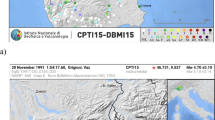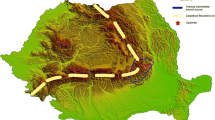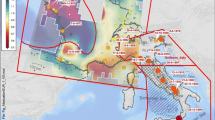Abstract
In this study, we propose new attenuation relations for use in possible future macroseismicity-based analyses for Turkey. The most significant difference of the new relationships is that they are specifically designed for use in the full extent of Turkey. Besides, this paper supplies an extensive macroseismic database larger than ever collected for Turkey. To this end, a modifiable MATLAB program, which is fully presented in the electronic supplement to this paper, was written to analyze the collected isoseismal maps that were first geo-rectified and then gridded by dividing them into 0.02° arrays. The epicentral distances belonging to each point intersected with the pertinent isoseism were compiled in an event-based log. Then, all subsets were merged into a single dataset, which is presented in the electronic supplement. Required strong ground motion parameters were taken from an improved earthquake catalog recently given by Kadirioğlu et al. (B Earthq Eng 1:2, 2016). For modeling the relations, the early relations were mostly selected as patterns for our candidate attenuation models. Of all candidate models, the statistically significant ones were individually tested whether or not they were able to detect the best fitting model to our database. The predicted error margins of the proposed models were compared to those of early models using data-driven statistical tests. In conclusion, considering the usability limits, the estimation capabilities of proposed relationships were found to be useful to some extent than those of the early models developed for Turkey.























Similar content being viewed by others
References
Ambraseys N (1985) Intensity- attenuation and magnitude- intensity relationships for northwest European earthquakes. Earthq Eng Struct D 13:733–778
Ambraseys NN (1988) Engineering seismology. Earthq Eng Struct D 17(1):1–105
Ambraseys NN, Finkel CF (1987a) The Saros Marmara earthquake of 9 August 1912. Earthq Eng Struct D 15(2):189–211
Ambraseys NN, Finkel CF (1987b) Seismicity of Turkey and neighboring regions, 1899–1915. Ann Geophys Ser B-Terr Planet Phys 5(6):701–725
Arioglu E, Arioglu B, Girgin C (2001) Assessment of the Eastern Marmara earthquake in terms of acceleration values. Beton Prefabrikasyon 57–58:5–15 (in Turkish)
Arpat E (1977) 1975 Lice Depremi (in Turkish). Yeryuvarı ve İnsan 2:15–28
Atkinson GM, Kaka SI (2007) Relationships between felt intensity and instrumental ground motion in the central United States and California. Bull Seismol Soc Am 97:497–510
Atkinson GM, Wald DJ (2007) “Did You Feel It?” intensity data: a surprisingly good measure of earthquake ground motion. Seismol Res Lett 78:362–368
Bakun WH (2005) Magnitude and location of historical earthquakes in Japan and implications for the 1855 Ansei Edo earthquake. J Geophys Res Solid Earth. https://doi.org/10.1029/2004JB003329
Bakun WH (2006) MMI attenuation and historical earthquakes in the Basin and Range province of western North America. Bull Seismol Soc Am 96:2206–2220
Bakun WH, Scotti O (2006) Regional intensity attenuation models for France and the estimation of magnitude and location of historical earthquakes. Geophys J Int 164:596–610
Bakun WH, Wentworth CM (1997) Estimating earthquake location and magnitude from seismic intensity data. Bull Seismol Soc Am 87:1502–1521
Bakun WH, Johnston AC, Hopper MG (2003) Estimating locations and magnitudes of earthquakes in eastern North America from modified Mercalli intensities. Bull Seismol Soc Am 93:190–202
Bilal M, Askan A (2014) Relationships between felt intensity and recorded ground-motion parameters for Turkey. Bull Seismol Soc Am 104:484–496
Bindi D, Parolai S, Oth A, Abdrakhmatov K, Muraliev A, Zschau J (2011) Intensity prediction equations for Central Asia. Geophys J Int 187:327–337. https://doi.org/10.1111/j.1365-246X.2011.05142.x
Bindi D, Parolai S, Gómez-Capera A, Locati M, Kalmetyeva Z, Mikhailova N (2014) Locations and magnitudes of earthquakes in Central Asia from seismic intensity data. J Seismol 18:1–21. https://doi.org/10.1007/s10950-013-9392-1
Blumenthal M, Pamir HN, Akyol HI (1943) Şimal Anadolu Zelzele Sahasının Jeoloji ve 1942 Yılı Sonunda Buralarda Yapılan Makrosismik Müşahadeler (Osmancık-Erbaa). MTA Mecmuası 8(1–29):33–58 (in Turkish)
Böse M (2006) Earthquake early warning for Istanbul using artificial neural networks. PhD. Thesis, Fakultät für Physik der Universität Hamburg
Böse M, Erdik M, Wenzel F (2007) A new approach to earthquake early warning. In: Earthquake early warning systems. Springer, Berlin, Heidelberg, pp 65–83
Bozkurt E (2001) Neotectonics of Turkey—a synthesis. Geodin Acta 14:3–30
Cecic I, Musson R, Stucchi M (1996) Do seismologists agree upon epicentre determination from macroseismic data? A survey of ESC Working Group ‘Macroseismology’. Ann Geophys 39, 5
Chatterjee S, Hadi AS (2015) Weighted least squares. In: Regression analysis by example. 5th edition, Wiley, pp 179–196. https://doi.org/10.1002/0470055464.ch7
Demirtas R, İravul Y, Erkmen C, Baran B, Yaman M, Kılıç T (2000) Orta (Çankırı) earthquake of June 6, 2000, Bull. Geology 1–2, 6–15 (in Turkish)
Demirtas R, İravul Y, Erkmen C, Yaman M, Kartal R, Baran B (2004) 25 ve 28 Mart 2004 Aşkale-Kandilli-Erzurum Depremleri (in Turkish), Afet İşleri Genel Müdürlüğü Deprem Araştırma Dairesi Başkanlığı
Doser DI (2009) Estimating magnitude and location of Alaskan earthquakes using intensity data. Bull Seismol Soc Am 99:3430–3453
Douglas J (2011) Ground-motion prediction equations 1964–2010. Pacific Earthquake Engineering Research Center Berkeley, Berkeley
Dowrick D, Rhoades D (2005) Revised models for attenuation of modified Mercalli intensity in New Zealand earthquakes. Bull N Z Soc Earthq Eng 38:185–214
Erberik MA (2008a) Generation of fragility curves for Turkish masonry buildings considering in-plane failure modes. Earthq Eng Struct Dyn 37:387–405
Erberik MA (2008b) Fragility-based assessment of typical mid-rise and low-rise RC buildings in Turkey. Eng Struct 30:1360–1374
Erdik M, Eren K (1983) Attenuation of intensities for earthquake associated with the North Anatolian Fault, Middle East Technical University Earthquake Engineering Research Center, Ankara.
Erdik M, Öner S (1982) A rational approach for the probabilistic assessment of the seismic risk associated with the North Anatolian Fault. In: Işikara AM, Vogel A (eds) Multidisciplinary Approach to Earthquake Prediction. Progress in Earthquake Prediction Research, vol 2. Vieweg+Teubner Verlag, Wiesbaden, pp 115–127
Erdik M, Doyuran V, Akkaş N, Gülkan P (1985) A probabilistic assessment of the seismic hazard in Turkey. Tectonophysics 117:295–344
Ergin K (1969) Observed intensity-epicentral distance relations in earthquakes. Bull Seismol Soc Am 59:1227–1238
Ergin K, Güçlü U, Uz Z (1967) Türkiye ve Civarının Deprem Katoloğu (in Turkish), İTÜ. Maden Fak. Arz Fiziği Enstitüsü Yayınları 24:1–169
Ergin K, Güçlü U, Aksay G (1971) Türkiye ve Dolaylarının Deprem Kataloğu (in Turkish), İ.T.Ü. Maden Fak. Arz Fiziği Enst. Yayınları, 28
Eyidoğan H, Güçlü U, Utku Z, Değirmenci E (1991) Türkiye Büyük Depremleri Makro-Sismik Rehberi (1900–1988) (in Turkish). İstanbul Teknik Üniversitesi Maden Fakültesi, Istanbul
Fırat O (2005) 12 Kasım 1999 Düzce Depreminin Makrosismik Araştırması (in Turkish), Master Thesis, İstanbul Üniversitesi, Jeofizik Mühendisliği Anabilim Dalı, İstanbul
Güçlü U, Uz Z (1967) Türkiye ve civarının deprem katalogu. İ.T.Ü. Maden Fak. Arz Fiziği Enst. Yayl., no. 24, 169 s
Güçlü U, Altınbaş G, Eyidoğan H (1986) Türkiye ve Çevresi Deprem Kataloğu (1971–1975, in Turkish), İTÜ, YBYK-UYG-AR Merkezi, Sismoloji ve Sismotektonik Alt Birimi, No:30
Gurpinar A, Erdik M, Oner M, Yusemen S (1979) Seismic risk analysis of Northern Anatolia based on Intensity attenuation. In: Proceedings of 2nd US national conference on: earthquake engineering, Stanford-CA, pp 72–81
Hancilar U, Tuzun C, Yenidogan C, Erdik M (2010) ELER software-a new tool for urban earthquake loss assessment. Nat Hazard Earth Sys 10:2677
Joyner WB, Boore DM (1981) Peak horizontal acceleration and velocity from strong-motion records including records from the 1979 Imperial Valley, California, earthquake. Bull Seismol Soc Am 71:2011–2038
Kadirioğlu FT, Kartal RF, Kılıç T, Kalafat D, Duman TY, Azak TE, Ozalp S, Emre Ö (2016) An improved earthquake catalogue (M ≥ 4.0) for Turkey and its near vicinity (1900–2012). B Earthq Eng 1:2. https://doi.org/10.1007/s10518-016-0064-8
Kalafat D, Güneş Y, Arpat E, Ölmez Y, Öz G, Horasan G, Kekovalı K, Öğütçü Z, Püskülcü S, Yılmazer M (2003) Mayıs 2003 Bingöl Depremi Ön Raporu (in Turkish), Boğaziçi Üniversitesi Kandilli Rasathanesi ve Deprem Araştırma Enstitüsü Sismoloji Servisi, 58
Kanamori H (2007) Real-time earthquake damage mitigation measures. In: Gasparini P, Manfredi G, Zschau J (eds) Earthquake early warning systems. Springer, Berlin, Heidelberg, pp 1–8
Ketin I, Abdülselamoğlu Ş (1966) 19 Ağustos 1966 Varto Depreminin Makrosismik İncelemesi Hakkında Rapor (in Turkish). İTÜ YBYK UYG. AR, Merkezi Sismoloji ve Sismotektonik Alt Birimi Arşivi
Ketin I, Roesli F (1953) Makroseismische Untersuchungen über das nordwest-anatolische Beben vom 18 März 1953. Eclogae Geol Helv 46:187–208
Kolçak D, Sipahioğlu S (1979) Batı Anadolu için geliştirilmiş deprem büyüklük—Şiddet-Uzaklık iliskisi (in Turkish), Deprem Araştırma Enstitüsü Bülteni 25, 28–47
Levret A, Backe JC, Cushing M (1994) Atlas of macroseismic maps for French earthquakes with their principal characteristics. Nat Hazards 10:19–46. https://doi.org/10.1007/bf00643439
Makridakis S, Wheelwright SC, Hyndman RJ (2008) Forecasting methods and applications. Wiley, Hoboken
Minson SE, Meier M-A, Baltay AS, Hanks TC, Cochran ES (2018) The limits of earthquake early warning: timeliness of ground motion estimates. Sci Adv. https://doi.org/10.1126/sciadv.aaq0504
Musson R (2005) Intensity attenuation in the UK. J Seismol 9:73–86
Musson RMW, Cecić I (2002) 49—Macroseismology. In: Lee WHK, Kanamori H, Jennings PC, Kisslinger C (eds) International geophysics, vol 81. Academic Press, Cambridge, pp 807–822. https://doi.org/10.1016/S0074-6142(02)80256-X
Nemati M (2016) Relationships between modified mercalli intensity and engineering ground-motion of the earthquakes in Persia. J Earthq Eng 20:795–808. https://doi.org/10.1080/13632469.2015.1104751
Öcal N (1958a) 16 Temmuz 1955 Söke-Balat Zelzelesi (in Turkish), Maarif Basımevi
Öcal N (1958b) Söke-Balat Zelzelesi (Söke-Balat earthquake), İstanbul Kandili Rasathanesi Sismoloji Yay, 2
Öcal N (1959) 20 Şubat 1956 Eskişehir Zelzelesinin Makro- ve Mikrosismik Etüdü (in Turkish), İTÜ
Özmen B (2000) İzmit Körfezi Depremi’nin Hasar Durumu: (Rakamsal Verilerle) (in Turkish). Türkiye Deprem Vakfı, Istanbul
Özmen B (2002) 3 Şubat 2002 Çay (Afyon) Depreminin Eşşiddet Haritası ve Hasar Durumu (Rakamsal Verilerle) (in Turkish). Afet İşleri Genel Müdürlüğü Deprem Araştırma Daire 4083:1
Pamir HN, Ketin I (1941) Das anatolische Erdbeben Ende 1939. Geol Rundsch 32(3):279–287
Pınar N (1953) Preliminary Note on the Earthquake of Yenice-Gönen, Turkey, March 18, 1953. Bull Seismol Soc Am 43(4):307–310
Pınar N, Lahn E (1952) Türkiye Depremleri İzahli Kataloğu (in Turkish), Akın Matbaacilik Limited Ortaklığı
Salomon-Calvi W, Kleinsorge H (1940) 19 Nisan 1938 Tarihli Kırşehir Zelzelesi ve Zelzele Mıntakalarında İnşaat ile İskan Hususunda Jeolojik Teklifler (in Turkish), Maden Tetkik ve Arama Enst. Seri B 5:5–28
Seymen İ, Aydın A (1972) Bingöl Deprem Fayı ve Bunun Kuzey Anadolu Fay Zonu ile İlişkisi (in Turkish), Maden Tetkik ve Arama Dergisi, 79
Sørensen M, Stromeyer D, Grünthal G (2009) Attenuation of macroseismic intensity: a new relation for the Marmara Sea region, northwest Turkey. Bull Seismol Soc Am 99:538–553
Sørensen M, Stromeyer D, Grünthal G (2010a) Intensity attenuation in the Campania region, Southern Italy. J Seismol 14:209–223
Sørensen MB, Stromeyer D, Grünthal G (2010b) A macroseismic intensity prediction equation for intermediate depth earthquakes in the Vrancea region, Romania. Soil Dyn Earthq Eng 30:1268–1278
Sponheuer W (1960) Methoden zur Herdtiefenbestimmung in der Makroseismik. Freiberger Forschungshefte, vol C88. Akademie-Verlag, Berlin
Stromeyer D, Grünthal G (2009) Attenuation relationship of macroseismic intensities in Central Europe. Bull Seismol Soc Am 99:554–565
Tselentis G-A, Danciu L (2008) Empirical relationships between modified mercalli intensity and engineering ground-motion parameters in Greece. Bull Seismol Soc Am 98:1863–1875. https://doi.org/10.1785/0120070172
Văcăreanu R, Iancovici M, Neagu C, Pavel F (2015) Macroseismic intensity prediction equations for Vrancea intermediate-depth seismic source. Nat Hazards 79:2005–2031. https://doi.org/10.1007/s11069-015-1944-y
Varazanashvili O et al (2018) GeoInt: the first macroseismic intensity database for the Republic of Georgia. J Seismol. https://doi.org/10.1007/s10950-017-9726-5
Yaghmaei-Sabegh S (2013) Analysis of applicability of seismic intensity estimation using fourier spectrum of ground motions for Iranian earthquakes. Pure Appl Geophys 170:597–606. https://doi.org/10.1007/s00024-012-0535-z
Yaghmaei-Sabegh S (2018) Macroseismic intensity attenuation in Iran. Earthq Eng Eng Vib 17:139–148. https://doi.org/10.1007/s11803-018-0430-4
Yaghmaei-Sabegh S, Tsang H-H, Lam NTK (2011) Conversion between peak ground motion parameters and modified mercalli intensity values. J Earthq Eng 15:1138–1155. https://doi.org/10.1080/13632469.2011.565861
Yalçın D, Eravcı YFB, Yanık K, Baykal M, Yenilmez G, Çetin C (2017) Afad-red rapid earthquake damage and loss estimation software: example of Adıyaman Samsat earthquake. In: 9th congress of the balkan geophysical society
Yarar R, Ergünay O, Erdik M, Eren K (1984) Attenuation of intensities in Turkey In: Proceedings of eighth world conference on earthquake engineering San Francisco, CA, vol 343–350
Acknowledgements
The authors would like to thank three anonymous reviewers for their helpful and constructive comments that greatly contributed to improving the final version of the paper. They would also like to thank the handling Editor (Prof. Dr. Aybige Akinci) for her generous comments and support during the all review process.
Author information
Authors and Affiliations
Corresponding author
Electronic supplementary material
Below is the link to the electronic supplementary material.
Rights and permissions
About this article
Cite this article
Bayrak, E., Nas, M. & Bayrak, Y. New macroseismic intensity predictive models for Turkey. Acta Geophys. 67, 1483–1513 (2019). https://doi.org/10.1007/s11600-019-00357-4
Received:
Accepted:
Published:
Issue Date:
DOI: https://doi.org/10.1007/s11600-019-00357-4




